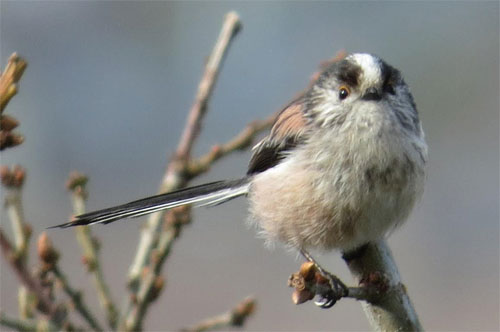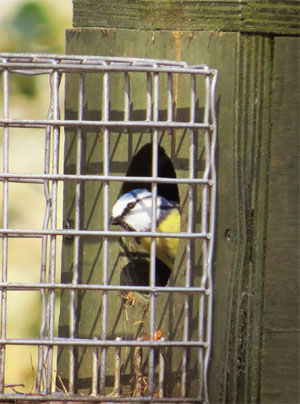| May
/ 2018 - Michael Ryan
|
|
During
the worst of the weather we had regular visits at our bird feeders from
a little flock of Long Tailed Tits. Making very distinctive ‘brup
brup’ calls to keep contact with each other, they often come through
the garden in stages, the leading bird might have already gone when the later ones are still arriving or else they might all group together on a fat ball or peanut container, the higher up bird’s tails overlapping the birds below. I remember somebody saying if it wasn’t for their tail they’d probably be our smallest bird species and they’re certainly one of our most endearing birds attracting lots of local names such as ‘flying teaspoons’. On a particularly cold, bleak evening during the grim weather in February, returning from visiting somebody in hospital, my spirits were lifted listening to the RTE broadcaster John Creedon speaking about the avian visitors to his garden and observing that the eyes of Long Tailed Tits seem to be more forward facing on their head than other birds species and when they look directly at you they seem to be engaging with you. Like our smallest bird species, the Goldcrest, long tailed tits display little fear of humans and are very approachable. I’d often be refilling feeders and a long tailed tit would perch a few feet away almost indifferent to my presence. |
|
|
We’d
noticed two long tailed tits were spending a lot of time around one
part of the garden, saw them regularly going into the foliage of one
small tree later seeing they were carrying in nesting material. Both
the male and female long tailed tit start nest building early in the
year, February sometimes, since it can take up to three weeks to build
their nest which is a wonder of nature, a dome shaped structure made
of moss, lichen, hair, silk from spiders webs, lined with up to two
thousand feathers and faced on the outside with lichen to help camouflage
it. The nest is often described as a elastic ball since the moss and
spider silk can expand so when the 8 to 12 chicks begin to grow the
nest will stretch to accommodate them. |
||
|
Blue
Tit checking out squirrel nest box
|
|
As
delightful as it to have these lovely little birds nesting in the garden
the future of the nest is also a cause for concern. A long term study estimated long tailed tits only succeed with 17% of their nests since many are lost to predators such as crows, magpies and cats. Many of the predated nests will have been built in the middle of gorse or bramble bushes so what chance do our pair have when their nest is in a small tree in the open? If we can easily see the pair coming in and out I’m sure much sharper eyed creatures would have no bother spotting them. One bit of behaviour related to failed nests goes a bit further towards enhancing the perception of long tailed tits as benign little creatures. If their nest is destroyed and it’s too late in the season to nest again they will help other long tailed tits, often ones related to them, to feed and raise their young. At time of writing, mid-April, we haven’t yet seen a swallow, house or sand martin in the damp angry skies or through the fog but the first weekend of April brought a number of Chiffchaffs into our garden and the following day we saw and heard our first Willow Warbler singing on Killiney Hill. The preceding days had strong south easterly winds blowing which possibly carried in the migrants which would then move out of the breeze to calmer areas where they’re more likely to find insects. Last year we spent a night at a very pleasant B&B in Thomastown in Kilkenny. Situated directly opposite Jerpoint Abbey the B&B has the substantial remains of an old mill in its grounds built beside a small river. Overlooking the river the patio had a profusion of Verbascum plants growing all over it, dozens of them, in varying sizes sprouting from the slightest crack between the tiles. With large, soft, almost furry leaves, verbascum, also known as Mullein, produces a tall spike in its second year which will be covered in small yellow flowers in mid-summer. My most impressive sighting of them many years ago was masses of them in flower on disturbed ground above Broadlough Lake near Wicklow town, a sea of soft green and yellow. It’s a native wild flower, a very valuable source of pollen for many insects especially in late summer. They seed and spread easily, growing out of very dry surfaces such as walls or rubble. The landlady of the B&B wasn’t as impressed with the wealth of wild plants as we were, telling us she was going to have the patio sprayed with weedkiller and told us we were welcome to as many as we wanted so we took her up on her offer. Very shallow rooted we were easily able to gather up a few dozen and bring them home and even managed to plant most of them. According to Zoe Devlin’s excellent website, wildflowersofireland.net the leaves also provide food for the mullein moth caterpillar and the seedheads are wintering habitat for ladybirds so if they flower this year hopefully they’ll provide food and shelter for some small creatures as well as a pleasant sight for the eyes. |
DALKEY
HOME PAGE | DALKEY
COMMUNITY COUNCIL | DALKEY
HERITAGE COMPANY | CANNONAID




